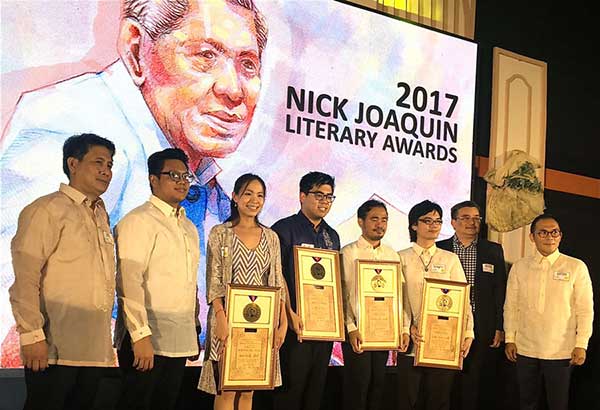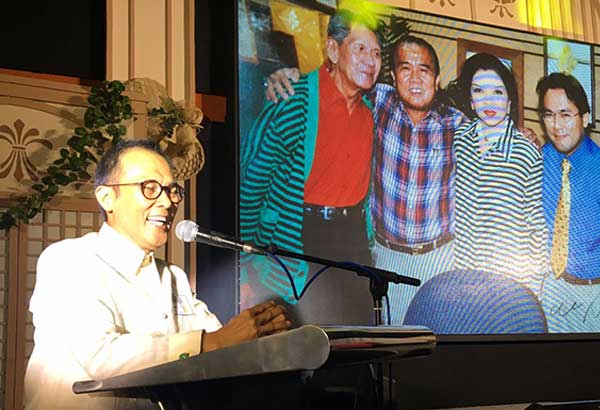Time with Nick


Poet of the Year Anne Carly Abad and story winners Scott Lee Chua, Christian Ray Buendia and Wayne Benitez Castillo are flanked by contest sponsors and Graphic president Benjamin Ramos and Aliw Media chair Edgard Cabangon.
Philippines Graphic magazine’s Nick Joaquin Literary Awards (NJLA) were given on Sept. 13 at the B Hotel in Quezon City. Three young fellows won the major prizes for their stories that had been published over the past year, while a young lady was declared as Poet of the Year for her contributions to the same literary pages.
A couple of our National Artists for Literature made it to the affair to receive their Guardian of National Memory awards. The attendees were F. Sionil Jose and Bienvenido Lumbera, while Virgiio Almario and Cirilo Bautista had to be proxied by younger and more handsome gentlemen of letters, one of whom was premier poet and translator Marne Kilates.
In his welcome remarks, publisher T. Anthony Cabangon highlighted the long association and deep friendship between his father, Graphic founder Ambassador Tony Cabangon Chua, and Nick Joaquin, its former editor in chief.
Current EIC Joel Pablo Salud spoke on the Guardian of the National Memory Award before host Claude Despabiladeras called on the National Artists to received their plaques from D. Edgard A. Cabangon, chairman of Aliw Media. Graphic president Benjamin V. Ramos then handed out the Patron of Literature Award to perennial sponsor PruLife UK.
A program feature billed as “Time with Nick” followed, with former Graphic editor Caloy Conde, and poet and feature writer Marra Lanot sharing anecdotes about NJ, before Charo Joaquin-Villegas expressed her appreciation for the magazine’s continuing tribute to her uncle.
Musical numbers were performed by Madonna Decena and the Chorale, who shared Nick’s favorite tunes, including his reworded version of Cole Porter’s You’re the Top.

Philippnes Graphic magazine publisher Anton Cabangon reminisces on the deep friendship between his father, Ambassador Tony Cabangon Chua, and Nick Joaquin, former Graphic editor in chief (both shown on the video screen).
Literary and associate editor Alma Anonas-Carpio then introduced the short story judges: Susan Lara, Sarge Lacuesta and this writer. Video evidence of our deliberations was shown onscreen. Per “Jerri” Anonas-Carpio, it was proof of transparency and even-handedness. Thankfully, edited out was a sequence when our deliberations had nearly turned violent.
Poet of the Year Anne Carly Abad, chosen by the Graphic editors, came with her husband Victor and their lucky charm, months-old baby Alphonse Rei Sebastian. We had known her to have been more of a fiction writer, who had attended the Ateneo National Writers’ Workshop for Fiction in 2009, and both the Iyas Creative Writing Workshop and the Silliman University National Writers Workshop in 2010 as a fellow for fiction, before she became a fellow for poetry at the Iligan National Writers Workshop in 2011.
Anne has an out-of-print novel, The Light Bringer’s Kingdom, published by Zharmae, as well as an e-book sci-fi short story collection, Gods, Ghosts and Battered Cellphones, through eTreasures Publishing in 2011.
The first-prize short story “Mathilde’s Absence” had figured in all three shortlists naming the judges’ respective top five stories, thus quickly establishing it as an apparent frontrunner. The second-placer “Margarita” had appeared in two judges’ shortlists. What eventually came out as the third-placer, “Certainly a train love story,” only appeared in one shortlist, but we agreed to reconsider all stories that appeared in any shortlist.
When we expressed our preferences for certain aspects of short story crafting, it turned out that we were one in giving premium to a story’s timespan. One judge specifically bewailed the high percentage of story submissions that had timeframes stretching out a narrative through long periods, with a few even involving decades.
Of course there can always be exceptions, but as a general rule, a compact story is strengthened by immediacy, a brief timeframe, and sharpened focus on few characters. Otherwise, the novella or novel would be the proper form for more ambitious narrative reckonings.
Yet another plus would be a judicious balance of exposition and dialogue that both advance a story forward, apart of course from the value of quick character development, some conflict, and possible resolution of that conflict. The story’s novelty and effective if not excellent writing are additional pluses. In broad strokes, these are what make a short story memorable.
“Certainly a train love story” emerged from a tie with two other contenders for third place. It did so on the strength of its novelty, primarily of setting, as it transpires on a mass-transit ride through parts of the city. In lieu of dialogue, internal musings are played out between the two characters.
“Margarita” gained the nod for second place. A single character is torn between continuing to care as a yaya for her young ward in the big city and riding a ferry back home to her real relations in Tagbilaran, from where she’s stayed away for 13 years. It is open-ended, but the crosscutting between past and present leads to a subtle suggestion that Rita won’t board the ferry.
“Mathilde’s Absence” has an unnamed housewife as the central character. She leaves her apparently jobless husband every day purportedly for work, which turns out to be for a cosplaying role she fulfills for her employer. He’s a widower who misses his late wife so much that he needs someone to take her place, to the extent of dressing up like her when she goes through the paces in welcoming him home when he gets back from work. The chores for which she’s paid include kitchen, bathroom and bed rituals.
Literary editor Jerri recalls how third-prize winner Wayne Benitez Castillo couldn’t believe it when his story was published. He paid the Graphic office a visit to say so, and got even more surprised when Jerri and EIC Joel took time out to converse with him and encourage him to keep on writing.
Second-placer Scott Lee Chua turned out to be a son of former math columnist and author Queena Lee Chua. Their family had resettled in Singapore, from where mother and son flew back home for the express purpose of having Scott receive his prize.
First-placer Christian Rey Buendia turned out to have been a Dumaguete workshop fellow for fiction last year, and a fiction fellow at the UST workshop in 2015, the same year he was a fellow for poetry in Filipino at the Palihang Rogelio Sicat.
It was a good thing that video documentation had been taken, and shown, of the judges’ deliberations, which established the anonymity of the writers. Both Susan Lara and I had paneled at the Dumaguete workshop last year, and had thus associated with the young Buendia. But we hadn’t known that he had written the first-prize story, his first published in Graphic. His previous stories were published in The Sunday Times Magazine in 2013 and 2015, when Elmer Ordoñez was the literary editor.
Christian currently works as program staff for an NGO that services indigenous people in Southern Tagalog. He’s also taking up MS Development Communication at UPLB, where he got his BS Civil Engineering degree two years ago.
Congrats to the NJLA winners, who received P50,000, P30,000 and P20,000, respectively, for their fine literary efforts.


















